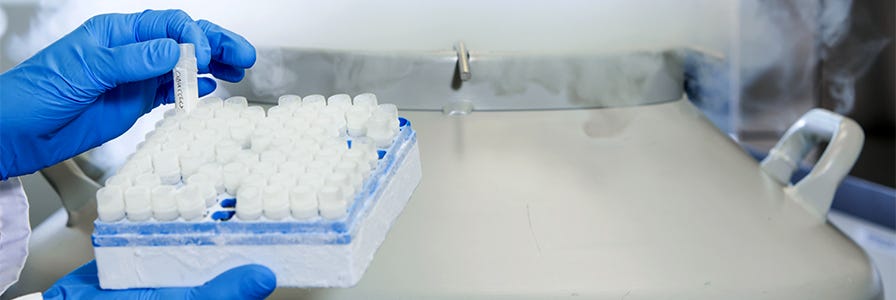How to Cryopreserve Peripheral Blood Mononuclear Cells (PBMCs)
Two options for successful cryopreservation of purified PBMCs
Cryopreservation is a commonly used method for long-term storage of cells, including human peripheral blood mononuclear cells (PBMCs) isolated from whole blood or leukopaks. To cryopreserve PBMCs, the cells are resuspended in cryopreservation medium, cooled to extremely low temperatures, then stored at liquid nitrogen temperatures (below -135°C) until needed. Once the cells are required, the cryopreserved PBMCs can be thawed and then used in downstream applications, such as further cell subset isolation using EasySep™.
A lab-made formulation of cryopreservation medium often contains fetal bovine serum (FBS), a nutrient-rich ingredient that protects cells and helps them recover after thawing. However, the use of FBS raises concerns about lot-to-lot variability and the risk of transmitting potentially infectious agents. FBS is usually not recommended for commercial or clinical applications, such as the production of biologicals. Dimethyl sulfoxide (DMSO), another additive that helps protect cells against osmotic lysis, is also a widely used cryoprotectant in cryopreservation media.
Using the appropriate cryopreservation medium, cell concentration, and freezing rate ensures that PBMCs maintain optimal viability and functionality upon thaw. The following protocol outlines two options for successful cryopreservation of purified PBMCs:
- Using a serum-free cryopreservation medium: CryoStor® CS10 (Catalog #07930), a serum- and animal component-free cryopreservation medium containing 10% DMSO, provides a safe, protective environment for cells and tissues during the freezing, storage, and thawing processes.
- Using a serum-containing formulation: A lab-made formulation containing 10% DMSO with 90% FBS solution is a commonly used, inexpensive, and effective cryopreservation medium.
Materials
- Cryopreservation medium. Options include:
- CryoStor® CS10 (Catalog #07930), or
- Dimethyl sulfoxide (DMSO) and fetal bovine serum (FBS)
- Cryogenic vials (e.g. Catalog #38053)
- Isopropanol freezing container (e.g. Corning® CoolCell® (Catalog #200-0642), Mr. Frosty™ or a controlled-rate freezer)
- Pipettor (e.g. Corning® Lambda™ Plus Pipettor, Catalog #38060)
- Pipette tips (e.g. Corning® Filtered Pipette Tips, Catalog #38034)
Protocol
Option 1: Cryopreservation with CryoStor® CS10
- Wipe down the outside of the CryoStor® CS10 container with 70% ethanol or isopropanol before opening.
- Label cryogenic vials.
- Ensure PBMCs are in a single-cell suspension. Centrifuge cells at 300 x g for 10 minutes to obtain a cell pellet.
- Carefully remove the supernatant with a pipette, leaving a small amount of medium to ensure the cell pellet is not disturbed.
- Resuspend the cell pellet by gently flicking the tube.
- Add cold (2 - 8°C) CryoStor® CS10, mix thoroughly, and transfer the suspension to a cryovial.
Note: It is recommended to freeze isolated PBMCs at a concentration of 0.5 - 10 x 106 cells/mL. However, you should try freezing the cells at multiple concentrations to determine which concentration gives the desired viability, recovery, and functionality upon thaw. Higher cell concentrations for freezing will need to be validated and optimized for specific applications as the major risk is the loss of viable cells. - Incubate cells at 2 - 8°C for 10 minutes.
- Cryopreserve cells using a standard slow rate-controlled cooling protocol (approximately -1°C/minute) on a controlled-rate freezer, or an isopropanol freezing container (e.g. Corning® CoolCell®, Mr. Frosty™ etc.). If using an isopropanol freezing container, place the cryogenic vials into the container, and place it in a -80°C freezer overnight.
- For long-term storage, transfer the vials of frozen PBMCs from the freezer or freezing container to vapor phase liquid nitrogen (below -135°C). Minimize exposure to room temperature by placing vials on dry ice during transfer to liquid nitrogen.
Note: Long-term storage at -80°C is not recommended.
Option 2: Cryopreservation in 10% DMSO with 90% FBS
Before You Begin:
- Ensure all media is cold prior to starting this protocol.
- If there are safety concerns related to using FBS, a serum- and animal component-free cryopreservation medium such as CryoStor® CS10 should be used.
- Prepare 20% DMSO in FBS. Keep on ice.
Note: Do not put 100% DMSO on ice or it will form crystals. Use a glass pipette for DMSO. - Label cryogenic vials.
- Ensure PBMCs are in a single-cell suspension. Centrifuge cells at 300 x g for 10 minutes to obtain a cell pellet.
- Carefully remove the supernatant with a pipette, leaving a small amount of medium to ensure the cell pellet is not disturbed.
- Resuspend PBMCs in cold FBS to a concentration of 1 - 20 x 106 cells/mL. Keep on ice.
- Mix cells gently with 20% DMSO in FBS at a ratio of 1:1. The final cell suspension will be in 10% DMSO and 90% FBS. The final cell concentration will be between 0.5 - 10 x 106 cells/mL. Rapidly transfer 1 mL of cell suspension to each cryovial.
Note: You should try freezing the cells at multiple concentrations to determine which concentration gives the desired viability, recovery, and functionality upon thaw. - Place cryogenic vials immediately into an isopropanol freezing container (e.g. Corning® CoolCell®, Mr. Frosty™ etc.). Place the container in a -80°C freezer overnight.
Note: Do not let cells sit in cryopreservation medium at room temperature. Keep on ice and transfer rapidly. - For long-term storage, transfer the vials of frozen PBMCs to vapor phase liquid nitrogen (below -135°C). Minimize exposure to room temperature by placing vials on dry ice during transfer from the -80°C freezer to liquid nitrogen.
Note: Long-term storage at -80°C is not recommended.
Request Pricing
Thank you for your interest in this product. Please provide us with your contact information and your local representative will contact you with a customized quote. Where appropriate, they can also assist you with a(n):
Estimated delivery time for your area
Product sample or exclusive offer
In-lab demonstration






